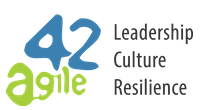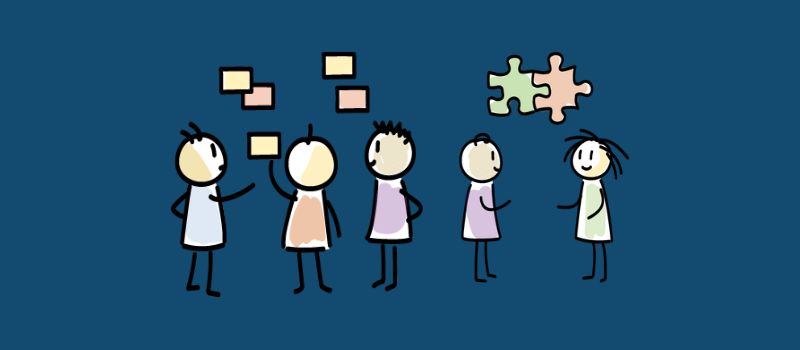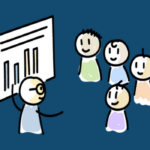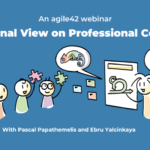How to Use Cultural Awareness and Coherence to Shape Your Company Culture
Have you ever wondered how you can nudge your company culture in the right direction? At agile42, we use the principles of ORGANIC agility to do that. ORGANIC agility® is an approach that we developed by working with hundreds of companies around the world. It provides a new leadership approach, models for cultural change, and insight into complexity thinking. The first principle of it is to Increase cultural awareness and coherence. It is only once we understand this that we can shape and improve our company culture. Let’s dive into what that means.
Understanding Organizational Culture
Organizational culture is the shared values, beliefs, and norms that influence how people behave within a company. It’s the invisible glue that holds an organization together, and it can influence our decision-making processes.
Ignoring organizational culture is not an option. A company’s culture is crucial to its success, and a toxic organizational culture can be very harmful, in more ways than one. A company’s culture is crucial to its success. Many people aren’t even aware of the culture they’re functioning in. By understanding organizational culture, we can form a shared pool of meaning. This can help us to interact with each other purposefully, reducing attrition and misunderstandings to a minimum.
Cultural Coherence vs. Alignment
In the context of organizational culture, it’s essential to understand the difference between “alignment” and “coherence.” Alignment requires everyone within the organization to get behind a specific value system, rituals, behaviors, and stories, in an attempt to align decisions and interactions. While this might seem like a good idea, it can actually be a very daunting task. And it can have some negative side effects. It may end up fostering compliance with “an artificial culture system” rather than learning from the existing culture and nudging it towards a more cohesive and coherent one.

Photo by George Bakos on Unsplash
And that brings us to coherence. Being coherent means understanding our goals and direction, but allowing people to get there by following different paths. This contrasts with alignment, where we try to identify the preferred path and ask everyone to align behind it. In order to increase coherence we need to be conscious of the existing culture and identify any overlap that may already exist between where you currently are and where you want to go. First, we should identify the so-called “adjacent possible.” This is a term borrowed from evolutionary biology, which refers to a set of possibilities available to individuals or organisms at the current point in time. It is the common ground that people can converge on to find new meanings and rituals.
By increasing coherence, companies foster diversity which has significant advantages when tackling unknown situations. It enables multiple parallel paths to be explored simultaneously, thereby increasing the likelihood of finding a solution that works for everyone more quickly. As a result, it increases our resilience and ability to adapt to change. By deepening our understanding of organizational culture and the difference between alignment and coherence, we can more effectively work toward fostering a resilient and cohesive culture that benefits everyone in the organization.
Organizational Culture is Complex
Organizational culture isn’t something you can merely plan or design. It’s a complex interplay of multiple interactions that produce various outcomes. We can observe these outcomes, but it’s challenging to understand exactly how they came to be. That is because culture is complex, according to the Cynefin Framework. It is complex because cause and effect can only be understood in hindsight. Furthermore, there’s no guarantee that we’ll be able to reproduce a specific outcome, even if we try to recreate the same situation. This is because circumstances will have changed, and our collective knowledge will have evolved to a different stage.
Trying to define and implement a culture might not be very valuable as culture is a continuous process of evolution. We all co-evolve with the culture we’re in, meaning that our interactions and experiences affect the cultural context in which we operate and that cultural context, in turn, influences our decisions and how we interact with others. This interplay is what defines the complex nature of culture.
Rather than attempting to simplify culture into something we can design and control, we should accept its complex nature and interact with it using complexity thinking techniques. The best way to invest our energy in improving organizational culture is to amplify the behaviors, rituals, and stories that produce better outcomes and dampen those that generate negative outcomes.
Watch our Webinar: How to Improve Company Culture
The Art of “Nudging” Organizational Culture
The term “nudging” embodies the idea that we don’t always know what kind of effect our interactions with our organizational culture will have beforehand. This means we’re trying something new and will observe how our actions affect the overall system, then adapt or continue based on what we see happening. It could be that our actions, along with other factors, contribute to the culture evolving in a more desirable direction.
It’s important to remember that the “direction” isn’t something we can arbitrarily set. Rather, it’s determined by the next adjacent possible state towards which a specific group of people could move to increase overall coherence.

Photo by Jamie Templeton on Unsplash
How to Measure and Observe Culture
We can’t design and implement the culture we want (since culture is more of a complex social system than an engineered structure). But, we can measure culture continuously and observe the effects that our actions have. Even if we don’t know exactly why things happen, we’ll be able to measure them and change our actions if the results aren’t moving in the right direction. Measuring these characteristics and observing how culture changes over time provides us with valuable insights into trends (vectors) about where the culture is moving.
By embracing the complex nature of organizational culture and focusing on nudging the culture in the right direction, we can create a more resilient and adaptable organization. An organization that’s better equipped to tackle challenges and thrive in today’s ever-changing world.
Measuring Culture with a Complexity Thinking Approach
A lot of HR professionals and leaders use traditional methods to measure company culture and assess employee hapiness. But these don’t always work because they often fail to capture all the nuances and subtleties of an organization’s culture. This is mostly because traditional approaches ask people to evaluate a particular situation or moment in time against a predefined “framework” which embodies assumptions and expectations. These approaches don’t allow us to learn anything new or see how our culture is evolving, as they tend to capture a specific moment in time. That’s where a complexity thinking approach comes in.

Photo by Hans-Peter Gauster on Unsplash
A New Alternative to Traditional Workplace Surveys
At agile42, we use sense-making and data to get a more adaptive and tailored understanding of an organization’s culture. This enables individuals to regularly capture their own stories against a set of customized signifiers. This sense-making approach doesn’t require people to evaluate their stories but rather interpret them. As a result, they are generally more honest and open about sharing their experiences. They don’t feel the pressure to provide the “right” answer. The resulting set of metadata can be analyzed and visually represented in what we call an organizational culture profile. While the collection of stories can be done in an analog way using paper letters or sticky notes, using a digital tool provides significant advantages when it comes to collecting, representing, and analyzing the results.
The tool we use to do this is called the Organizational Scan™. This powerful instrument helps us measure culture effectively. It does this by highlighting nuances and outliers that might be overlooked in traditional deterministic approaches.
The OrgScan captures stories from individuals by following a specific prompt, based on decisions. So every time someone is impacted positively or negatively by a decision made within the organization, they are asked to capture a story sharing how they have been affected. This captures the nuances of each story while enabling individuals to interpret their own stories by highlighting the aspects they feel are most important. In this way, through self-interpretation, the cultural nuances will emerge and contribute to the overall dataset, providing information about trends, the direction of movement, and the overall culture profile. In this way, organizations can gain valuable insights into their culture, better understand its nuances, and identify trends that can help guide their efforts to nudge the culture in a more desirable direction.
Measure your culture using the Organizational Scan™ now
How Hard is it to Measure Culture?
You might be wondering if measuring culture is a complicated or expensive process. With the self-interpreted narrative approach, it doesn’t have to be. This method helps reduce survey fatigue and encourages involvement by integrating the journaling process into day-to-day work. If everyone can use a few minutes a day within an organization to capture a couple of stories every week, you will be able to build a solid and up-to-date data set with minimal effort. One of the challenges is getting people to share their stories, especially if it isn’t clear or explicit what will be done with their contributions.
How to Shape Company Culture
Now that we have a clear understanding of cultural coherence and how we can work toward a more desired state, it is necessary to define the direction and the steps to take to get there. This will involve understanding organizational culture profiles, characteristics, dimensions, leadership styles, and the various adjacent possible states.
But we also need to understand organizational archetypes, how to map stories of success and failure to these archetypes, and how to discover new archetypes. In the ORGANIC agility (OA)framework, an archetype is the behaviors of leaders and teams within the context that they operate. It includes the relationship between team members and their leaders and with the organizational culture as a whole.
Within the OA framework, there are four key organizational archetypes: Expert, Co-ordinator, Peer, Coach, and Strategist. Each represents a set of behaviors and interpersonal traits that can give a snapshot into your culture. Once you identify the archetypes you want to work toward, it is much easier to nudge the culture in that direction.
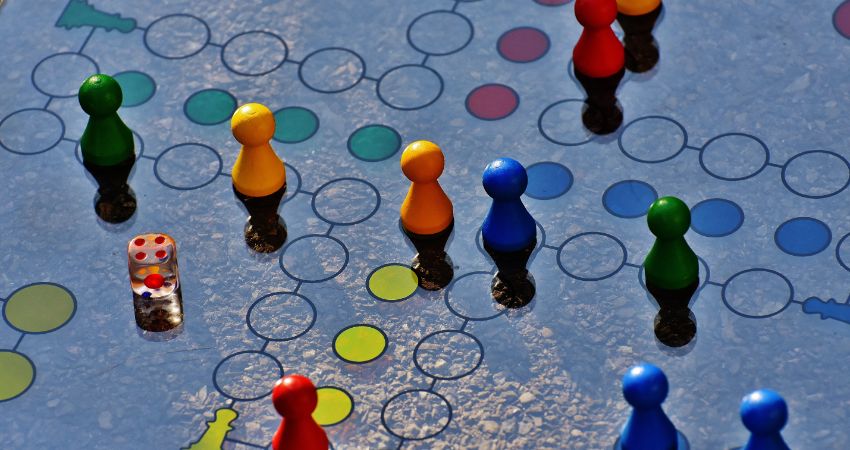
Photo by Pixabay
How to Leverage OrgScan Data to Shifting Culture
Our Organizational Scan can help you to collect stories of failure and success. It maps stories to leadership and organizational archetypes to understand how archetypes are associated with culture on a high level. The OrgScan helps you to increase the level of coherence in an organization or team by:
- Identifying adjacent possibilities
- Identifying stories in adjacent possibilities areas or in the vector direction
- Determining which archetype stories are associated with
- Mapping behaviors to archetypes, and identifying continuity links
- Creating leadership circles to work out how to move toward the adjacent possible
- Regularly share experiences and approaches so that people can learn from each other and approach situations with different behaviors to increase overall cultural coherence
If the level of coherence is satisfactory, the tool will help you to identify in which direction the culture should be nudged, identify stories of success and failure from the target culture, and map out how we can move toward the desired behaviors. Our team of experts can help you to do this and guide you through the process.
Get in touch with our team
Increasing resilience is an ongoing process
In order to gain a higher level of resilience, organizations need to adapt their culture and context to address the issues at hand. This is only possible when we learn how to consciously address culture, create more coherence, and shift culture toward a specific direction. Culture is constantly changing and co-evolving with the people in it. The faster the organization grows the more likely it is that the culture will be constantly challenged. When you improve culture, you also speed up adaptability to changes and recovery from failure, which will make your organization more resilient and competitive in the market.
